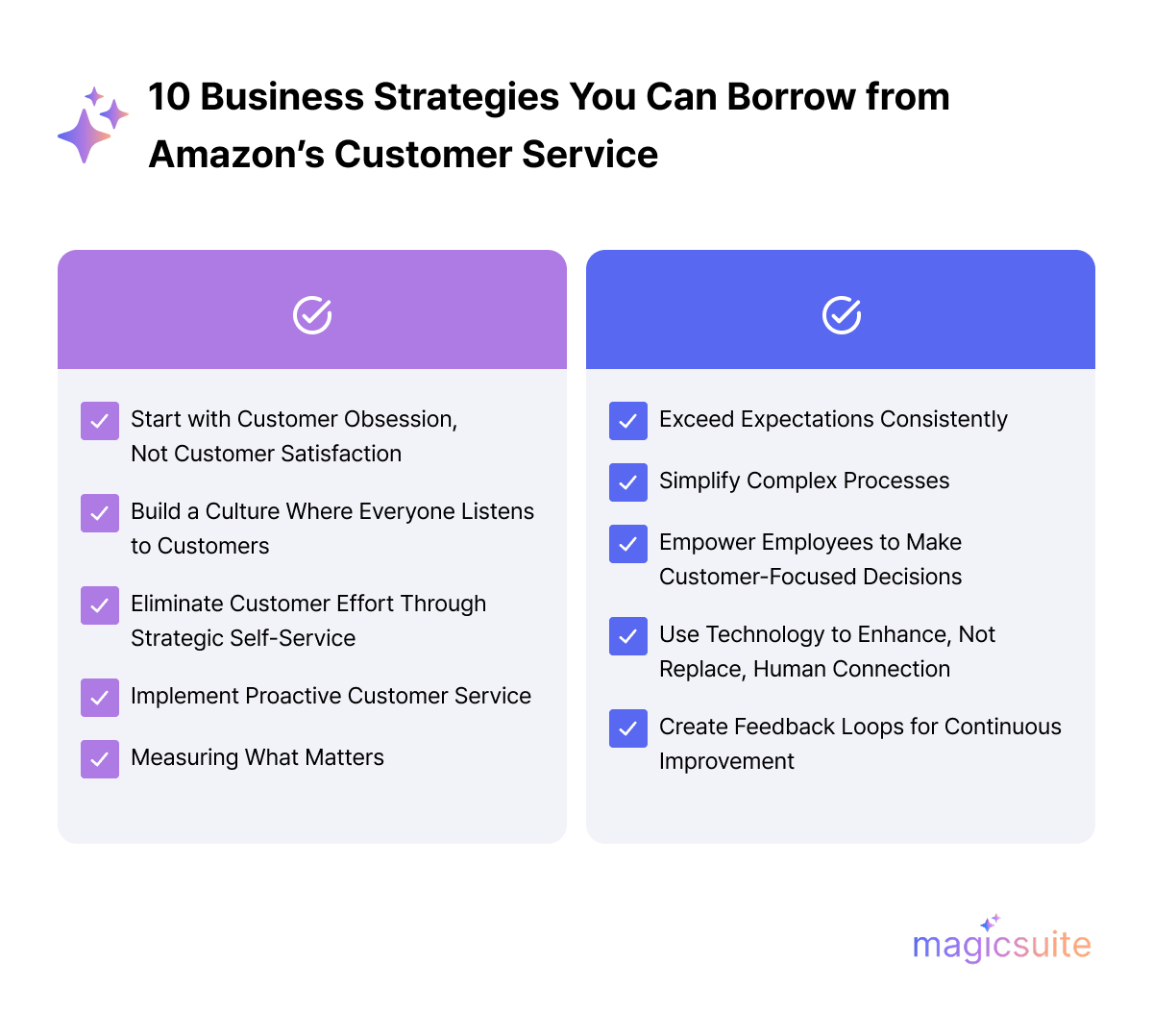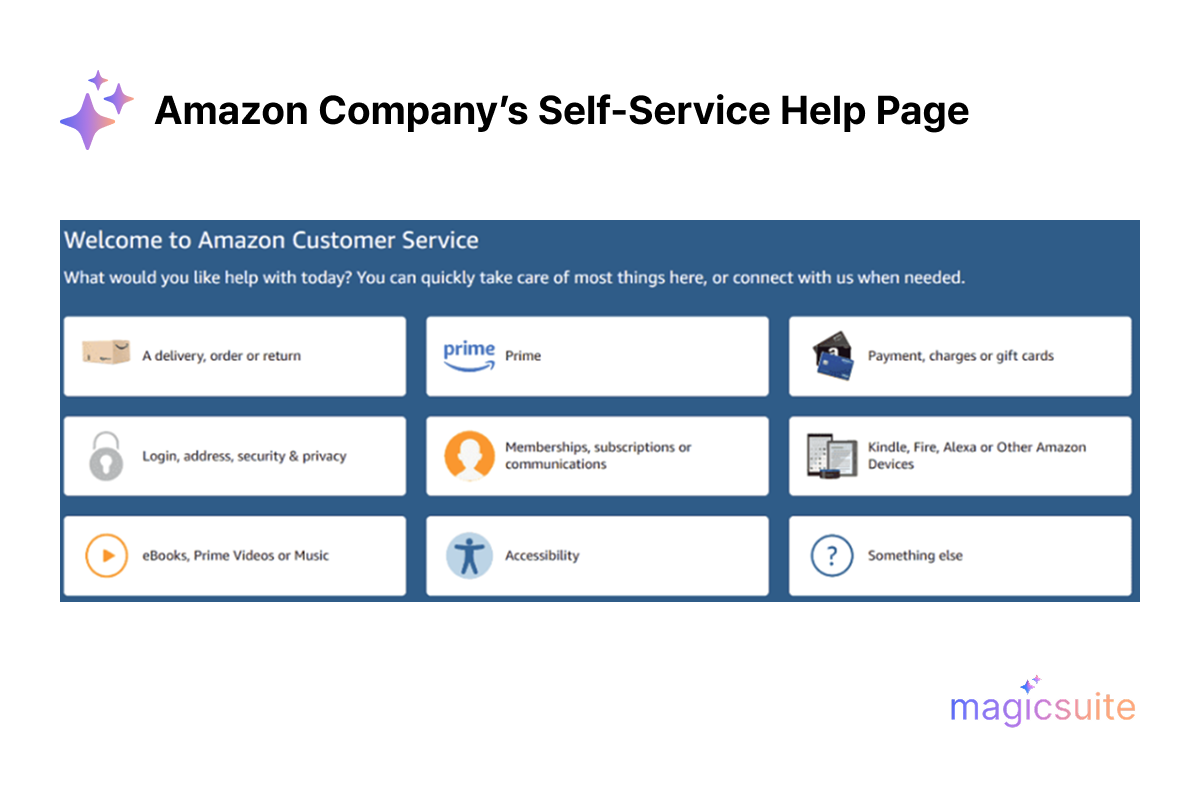Discover 10 key customer service lessons from Amazon that can help businesses improve customer satisfaction, boost loyalty, and enhance operational efficiency.

Let Amazon’s legacy be your blueprint for success. Amazon has established itself as the global benchmark for customer service excellence, earning a 95% customer satisfaction rating and becoming synonymous with customer-centric business practices.
Whether you're a startup or a multinational corporation, there are invaluable insights to be gleaned from Amazon’s approach to customer care. This comprehensive guide explores ten transformative lessons businesses can learn from Amazon’s customer service strategy, complete with real-world applications, SEO-optimized insights, and actionable takeaways.

Amazon's foundational principle goes beyond merely satisfying customers—it demands obsession. As outlined in their 16 leadership principles,
"Leaders start with the customer and work backward. They work vigorously to earn and keep customer trust. Although leaders pay attention to competitors, they obsess over customers."
This obsession manifests in their mission statement: "to be Earth's most customer-centric compan." Jeff Bezos famously implemented the "empty chair" practice in meetings, where an empty chair represents the customer's perspective, ensuring every decision considers the customer first.
Business Application: Replace customer satisfaction metrics with customer obsession metrics. Make customer impact a primary consideration in all strategic decisions, not just an afterthought.
Many Amazon employees, regardless of their role, undergo two days of call center training to learn how to listen—not just talk—to customers. This practice helps employees across departments understand customer pain points and develop empathy for the customer experience.
The company also maintains six core customer service tenets that are prominently displayed in their offices, including "Relentlessly advocate for customers" and "Trust our customers and rely on associates to use good judgment".
Business Application: Implement cross-departmental customer service training. Ensure that employees from all departments—engineering, marketing, and finance—spend time directly interacting with customers.
Amazon follows a systematic approach in its Amazon Customer Service Chat to reduce customer effort, prioritize defect elimination, and provide self-service, automation, and expert support in that order. The company encourages customers to solve problems through self-service tools on their website and app, which work effectively for common issues like order tracking and returns
This strategy serves dual purposes: it reduces operational costs while providing customers with immediate solutions, eliminating the need for them to wait for support.
Business Application: Audit your customer service touchpoints and identify opportunities for self-service. Create comprehensive FAQ sections, video tutorials, and automated tools that address the most common customer issues.

Rather than waiting for customers to encounter problems, Amazon’s customer service chat proactively addresses potential issues before they become complaints. Through Amazon Connect, the company now enables proactive communications for service updates, promotional offers, and appointment reminders at optimal moments in the customer journey.
Business Application: Use customer data and analytics to identify patterns that indicate potential problems. Set up automated systems to reach out to customers proactively when issues are likely to occur.
Amazon doesn’t just collect data—it uses it to improve. Key performance indicators (KPIs), such as Net Promoter Score (NPS), Customer Satisfaction Score (CSAT), and First Contact Resolution (FCR), are closely monitored.
Metrics to Track:
SEO Angle: Data-driven decisions lead to better content, UX, and conversion rates.
Amazon has built a reputation for consistently delivering beyond what customers expect. They often deliver packages faster than promised delivery dates by coordinating with local distributors and freelance couriers. This practice of under-promising and over-delivering creates positive surprises that enhance customer loyalty.
The company also goes beyond basic service requirements. For example, Amazon's A-to-Z Guarantee protects customers even when they purchase from third-party sellers, demonstrating the company's commitment to customer protection regardless of the transaction source.
Business Application: Build buffer time into your service promises and delivery schedules to ensure timely completion. Look for opportunities to surprise customers positively, whether through faster delivery, additional services, or unexpected value-adds.
Amazon's One-Click ordering system enhanced e-commerce by streamlining the checkout process to a single click, leading to a 70% decrease in cart abandonment rates. The company continuously works to simplify processes across all touchpoints. Their return process is streamlined with prepaid shipping labels and clear instructions, making returns as easy as possible for customers.
Business Application: Map your customer journey and identify every point of friction. Eliminate unnecessary steps, reduce the number of form fields, and automate routine processes to make interactions as seamless as possible.
Also check out Easy-to-Implement Solutions to Reduce Cart Abandonment
Amazon trusts its associates to use good judgment when solving customer problems, as stated in their customer service tenets. This empowerment enables front-line employees to resolve issues quickly without escalating to management. The company provides clear guidelines but gives employees flexibility in how they apply these principles to individual situations.
Business Application: Provide customer service employees with apparent authority to resolve issues within defined parameters. Train them on company values and empower them to make decisions that benefit the customer, even if it means short-term costs.
Amazon strategically uses AI and automation in its customer service chat to handle routine inquiries. Their AI-driven chatbots handle immediate responses and common questions, while human agents focus on problems that require empathy and creative problem-solving.
The company's Customer Service by Amazon program exemplifies this balance, offering 24/7 automated support while maintaining human oversight and intervention as needed. This approach achieves 85% customer satisfaction and 82% first-contact resolution rates.
Business Application: Implement self-service technology, such as MagicTalk, that can automatically answer common questions using documentation, FAQs, or past resolved tickets. Additionally, route complex tickets to the most appropriate agent or department based on the nature of the query.
Amazon doesn't just collect customer feedback; it actively uses it to drive improvements in products and services. Their review system serves as a continuous feedback mechanism that influences product development, seller policies, and service enhancements.
The company treats customer complaints not as problems to solve, but as data points that can inform better business decisions.
Business Application: Establish systematic processes for collecting, analyzing, and acting on customer feedback. Create regular reviews of customer service data to identify trends and opportunities for improvement. Most importantly, close the loop by communicating improvements back to customers.
By learning from the best, you can become the best.
Amazon’s customer service success is not just about technology—it’s about culture, leadership, and a deep understanding of what customers value. Adopt these ten lessons, and your business can elevate its customer experience, increase loyalty, and gain a competitive edge in today’s experience-driven economy.
Amazon maintains high satisfaction through fast service, proactive communication, and a relentless focus on customer needs. Their customer-first philosophy guides every decision.
Amazon uses a combination of AI chatbots, CRM systems, and human agents to deliver seamless support across channels. Learn more about AI in customer service.
Absolutely. While you may not have Amazon’s resources, you can adopt their principles—like customer obsession, transparency, and data-driven decision-making. Explore customer service best practices.
Personalization increases engagement, satisfaction, and loyalty. Amazon uses data to tailor experiences, which you can replicate using CRM tools.
Amazon resolves complaints quickly through empowered agents, clear policies, and proactive outreach. Their approach minimizes friction and maximizes trust. Read more about complaint resolution strategies.

Ace is the product manager of MagicSuite and multiple other projects at Makebot AI. With extensive experience in product development and leadership, Ace ensures that each project aligns with market needs and delivers innovative solutions. Passionate about technology and automation, Ace plays a crucial role in shaping AI-driven products that enhance efficiency and user experience.